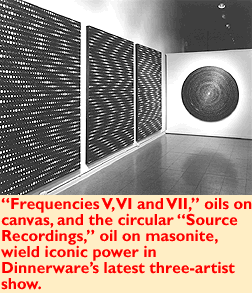ON THE BOOKSHELVES in Emily Dickinson's family home in Amherst, Massachusetts, were two volumes of advice for young ladies, both, naturally, written by men.
With all the pompous self-confidence of the mid-19th century male, both authors lectured women on how to live their lives. Joseph Lyman, author of Philosophy of Housekeeping, is full of high-falutin' blather about woman's sacred duty to be a wife and mother; but he brings her high moral mission down to being handy around the kitchen. "The art of making perfect bread," he advises the "vestal priestesses" of the home, "...outweighs every other domestic merit."
 In the other book, Letters on Practical Subjects --a
gift to Emily from her father--William Buell Sprague is more intent
on telling Lyman's exalted bakers to just plain shut up. Midway
through a long diatribe cautioning women to hold their tongues,
Sprague delivers cutting words whose effect on a beginning young
poet we can only guess:
In the other book, Letters on Practical Subjects --a
gift to Emily from her father--William Buell Sprague is more intent
on telling Lyman's exalted bakers to just plain shut up. Midway
through a long diatribe cautioning women to hold their tongues,
Sprague delivers cutting words whose effect on a beginning young
poet we can only guess:
"You are never to make yourself very conspicuous in conversation...Guard your lips then whenever you find it in your heart to make yourself the heroine of your own story."
Dickinson, thank goodness, ignored the commands of both men and went on to make herself very much the heroine of her own story. She may or may not have mastered breadmaking, but she composed some of the best American poetry ever written. By contrast, the supercilious Lyman and Sprague might well have languished forever in the literary dustbin had their words not been resurrected by Tucson artist Barbara Penn and put on display in a new show at Dinnerware.
A UA art prof, Penn has spent the last four years engaged in an interesting work of cultural archaeology, excavating the restrictive world that conspired to silence Dickinson and translating her finds into sculptural installations of poetic loveliness. She typically builds architectural structures that limit and define female space, and incorporates fragments of texts and female domestic handiwork. This time around, by using extracts from instructional manuals for women, Penn gets even closer than usual to helping us imagine the cultural sea in which Dickinson was forced to swim.
In "Letters on Practical Subjects," inspired by the verbose Sprague, a spinning wheel churns out a long, narrow length of canvas that Penn has painted with Sprague's peevish words. The canvas stretches a dozen feet or more across the floor and rises up to the far wall. On the adjoining wall, a couple of dark paintings are bisected by a dirty mattress cover, left unwashed, presumably, by some neglectful female intent on wagging her tongue. There's also a handmade antique nightgown, and draped cloths that look like bedsheets.
"The Philosophy of Housekeeping" is a simpler piece that stays on the wall. Divided into two parts, it also incorporates words, this time Lyman's, which Penn has painted onto a canvas bound with cloth at the sides. The top section harbors bits of a woman's dress and sports a long, cloth braid.
Both works can be easily read as elegant metaphors for the tight webs that bound 19th-century women, webs woven in equal parts by men's restrictions, reproduction and sexuality, and by endless domestic chores. But they're not just political documents. Penn, who will be the featured artist at the University of Arizona faculty show next month, used to be a painter. Her assembled pieces have an aesthetic rigor, even beauty, not often seen in installation work. She works in a lovely subdued palette of ivory-yellow, white and black, skillfully wielding her texts and nighties and skeins as she used to manage her paints.
On the gallery's other wall, Ellen McMahon, another UA prof, uses texts of another sort. Her subject is contemporary motherhood, and her real-life experiences compose a powerful reply to Lyman's silly sentimentalities across the wall. McMahon's elegant calligraphic drawings chronicle Everymother's story of passion, of fatigue, of fear. "Maternal Alphabet," a series of 20 black-and-white charcoal drawings on paper, turn the tools of the nursery, the breast pump, the pacifier, the nose syringe, into looming objects that can either save or harm a baby. Similarly, other drawings show the ambivalence of life in the family, where passion can erupt into violence, and where children are simultaneously in both the safest and the most dangerous place to be. A self-portrait shows McMahon's face smothered by one of those tiny baby undershirts, and a mean-looking hammer pokes out of another shirt.
Like Penn and McMahon, the third artist in the show, Katherine Josten, works in a monochromatic palette and in texts. She's a painter who teaches at Pima Community College and founded the Global Art Project. Josten works exclusively in black and white, etching script words into painted canvases cut into circles and squares. Some of her pieces, such as the Frequencies series of vibrating white dots against black, seem like tepid renditions of Op Art. But Josten herself says that all her work is based on a strange metaphysical experience she had 20 years ago; her paintings are meant to be spiritual communications from her source of wisdom. The dots of Frequencies hint at some out-of-galaxy messaging. "Source Recordings," a giant circle some 5 feet wide, conveys an obscure message in an invented language. The solemn religious overlays to Josten's pieces are a bit much to take and, standing alone, each one doesn't add up to much. But assembled as they are at Dinnerware, some 11 paintings strong, they do wield an uncanny, iconic power.





